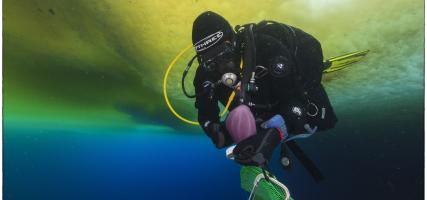
Recherche
Affiner les 188 résultats
, 2019 — « Morpho-functional study of extant canids: application to the Romanian Neolithic » in Colloque international «Les sociétés préhistoriques dans l’espace carpato-danubien: environnements, systèmes techniques, interactions»(Bucarest, ROUMANIE, 24-27 juin 2019).. , ,
, 2019 — Interspecific variation in the limb long bones among modern rhinoceroses — extent and drivers. Among amniotes, numerous lineages are subject to an evolutionary trend toward body mass and size increases. Large terrestrial… PeerJ vol. 7, , e7647
, 2019 — Captivity and cranial development in wild boar (Sus scrofa): exploration of new markers of the process of domestication. , ,
, 2017 — Stone tool forms and functions: a morphometric analysis of modern humans’ stone tools from Song Terus Cave (Java, Indonesia). archaeometry: bulletin of the research laboratory for archaeology and the history of art, oxford university vol. 59, n° 3, p. 455-471
, 2017 — Does diet drive the evolution of head shape and bite force in chameleons of the genus Bradypodion?. Functional Ecology vol. 31, n° 3, p. 671-684
, 2017 — « Form and function of the hominids thumb: Link between in-hand movements and the trapeziometacarpal complex » in Folia primatologica.. vol. 88, , p. 140
, 2018 — Morphological distinction between sheep (Ovis aries) and goat (Capra hircus) using the petrosal bone: application on French protohistoric sites. , ,
, 2018 — Commensalism and domesticity in canids from the old world from the Late-Glacial to Holocene. , ,
, 2019 — Rapport d’activité du projet ATM ArviClim - Arvicanthis : des climats et des hommes au Pléistocène et à l’Holocène en Afrique (dir. E. Stoetzel & R. Cornette). , ,
, 2019 — Limited thermal plasticity and geographical divergence in the ovipositor of Drosophila suzukii. Royal Society open science vol. 7, n° 1, p. 191577
, 2015 — Quantitative inferences on the locomotor behaviour of extinct species applied to Simocyon batalleri (Ailuridae, Late Miocene, Spain). The Science of Nature vol. 102, 5-6, p. 1-13
ISSN
0028-1042
, juin 2016 — Sexual dimorphism among Mesoamerican turkeys: A key for understanding past husbandry. Journal of Archaeological Science: Reports vol. 10, , p. 526-533
ISSN
2352409X
, mars 2016 — Molecular and morphological insights into the origin of the invasive greater white-toothed shrew (Crocidura russula) in Ireland. Biological Invasions vol. 18, n° 3, p. 1-15
ISSN
1387-3547
, février 2017 — Evolutionary history of the Persian Jird, Meriones persicus, based on genetics, species distribution modelling and morphometric data. Journal of Zoological Systematics and Evolutionary Research vol. 55, n° 1, p. 29-45
ISSN
09475745
, 2016 — Do adult phenotypes reflect selection on juvenile performance? A comparative study on performance and morphology in lizards. Integrative and Comparative Biology vol. 56, n° 3, p. 469-478
ISSN
1540-7063, 1557-7023
, décembre 2016 — Morphological analysis of long bones in semi-aquatic mustelids and their terrestrial relatives. Integrative and Comparative Biology vol. 56, n° 6, p. 1298-1309
ISSN
1540-7063, 1557-7023
, février 2016 — Biomechanical evolution of solid bones in large animals: a microanatomical investigation. Biological Journal of the Linnean Society vol. 117, n° 2, p. 350-371
ISSN
00244066
, mars 2017 — Swimming and running: a study of the convergence in long bone morphology among semi-aquatic mustelids (Carnivora: Mustelidae). Biological Journal of the Linnean Society , ,
ISSN
0024-4066, 1095-8312
, 2015 — Do constraints associated with the locomotor habitat drive the evolution of forelimb shape? A case study in musteloid carnivorans. Journal of Anatomy vol. 226, n° 6, p. 596-610
ISSN
1469-7580
, 2015 — Phenotypic plasticity and modularity allow for the production of novel mosaic phenotypes in ants. Evodevo vol. 6, , p. 36
ISSN
2041-9139






